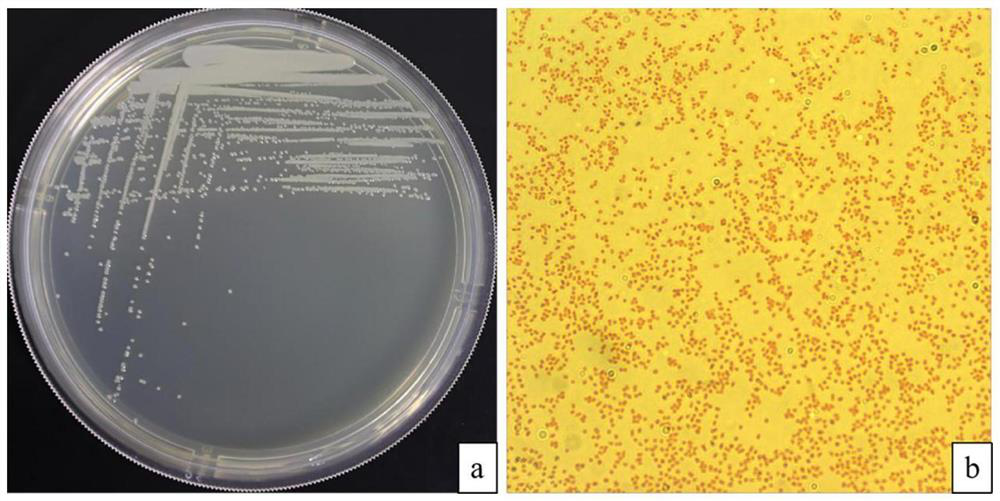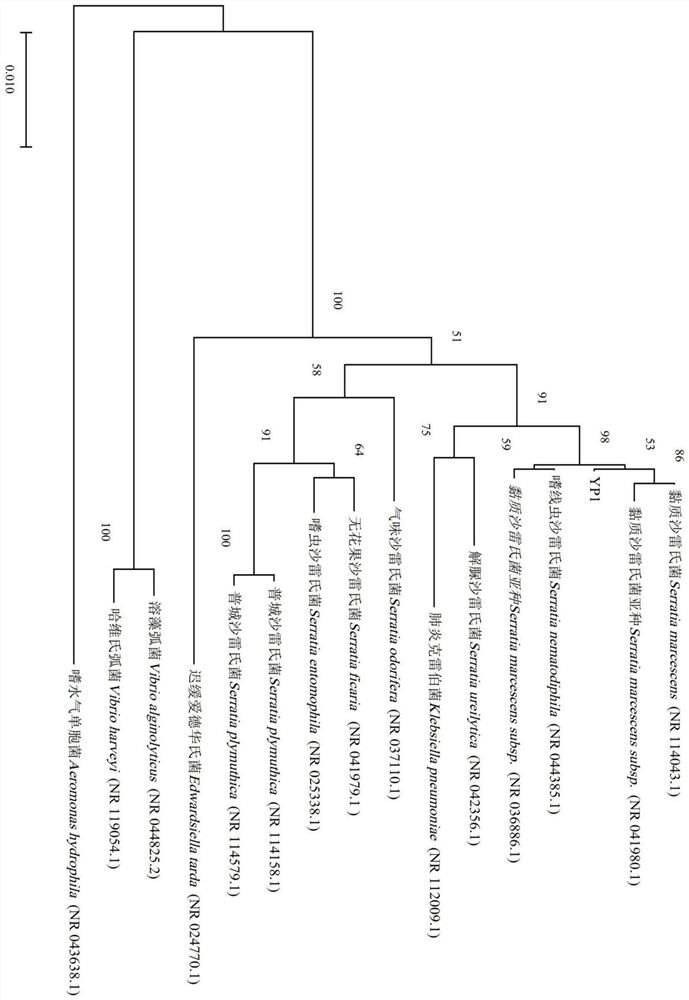Serratia marcescens YP1 with strong pathogenicity and strong drug resistance to fishes and application of serratia marcescens YP1
A technology of Serratia marcescens and drug resistance, applied in the field of microorganisms, can solve the problems of economic loss of aquaculture production, the advent of an effective vaccine for Serratia marcescens, etc., to achieve effective dissemination and epidemic, prevention and control of transmission and popular effects
- Summary
- Abstract
- Description
- Claims
- Application Information
AI Technical Summary
Problems solved by technology
Method used
Image
Examples
Embodiment 1
[0028] A strain of Serratia marcescens, the Latin name is Serratia marcescens, the laboratory number is YP1, isolated from the skin ulcer lesions of the diseased flounder, preserved in the China Collection of Type Cultures (CCTCC), the preservation address is Hubei No. 299, Bayi Road, Wuchang District, Wuhan City, Province, the preservation number is CCTCC NO: M 20211340.
[0029] 1. Isolation process of strains
[0030] The strain was isolated from the tissue of the surface ulcer of the flounder (body weight: 555.27±83.32 g) suffering from ascites and ulcer disease in a farm in Leting County, Hebei Province. The specific separation process is as follows: aseptically collect the tissue from the ulcer lesions on the surface of the diseased flounder, and perform tissue homogenization. Dip the tissue homogenate with a sterile cotton swab, streak it into a solid nutrient agar medium, and after culturing at 30°C for 24 hours, pick a single colony of the dominant colonies on the me...
Embodiment 2
[0051] Pathogenicity testing
[0052] 1. Flounder infection experiment
[0053] The healthy flounder (body weight: 25.20±5.0 g) used in the artificial resensitization experiment was obtained from the Beidaihe Central Experimental Station of the Chinese Academy of Fishery Sciences, obtained from a family of artificially induced gynogenesis, with high homozygosity and genetic similarity.
[0054] 210 flounders (weight: 25.20±5.0g) were randomly selected and divided into 7 groups with 30 tails in each group. They were reared in a 300L circular glass fiber reinforced plastic water tank with a water temperature of 21±1℃ and a daily water change of 50%. Start the experiment a few days later. The preparation method of the injection bacterial solution was based on Wang Lei et al. (Wang Lei, Chen Songlin, Zhang Yingping, Fan Caixia, Liu Yang, Tian Yongsheng, Deng Han, Liu Shoutang, Sun Deqiang, Xie Mingshu, Li Wenlong. Screening and analysis of three consecutive generations of flounde...
Embodiment 3
[0072] Drug sensitivity test:
[0073] According to the experimental operation standard of the Clinical Laboratory Center (NCCL) of the Ministry of Health, the sensitivity of the strain YP1 obtained in Example 1 to drugs was detected by the K-B method of paper diffusion. 8 cfu / ml) was spread on the MHA medium, and the drug sensitive patch was pasted on the medium with sterile tweezers after 5 min. After culturing at 30°C for 18 hours, the diameter of the inhibition zone was observed and measured, and the resistance of the pathogenic strains to antibiotics was determined. The susceptibility results of strain YP1 to the 32 antibiotics tested are shown in Table 4.
[0074] Table 4 YP1 drug susceptibility test results
[0075]
[0076]
[0077] Note: S: highly sensitive; I: moderately sensitive; R: resistant.
[0078] It can be concluded from Table 4 that, compared with other fish, mammals and other animal-derived strains (Serratia marcescens), the strain YP1 is more resi...
PUM
 Login to view more
Login to view more Abstract
Description
Claims
Application Information
 Login to view more
Login to view more - R&D Engineer
- R&D Manager
- IP Professional
- Industry Leading Data Capabilities
- Powerful AI technology
- Patent DNA Extraction
Browse by: Latest US Patents, China's latest patents, Technical Efficacy Thesaurus, Application Domain, Technology Topic.
© 2024 PatSnap. All rights reserved.Legal|Privacy policy|Modern Slavery Act Transparency Statement|Sitemap



